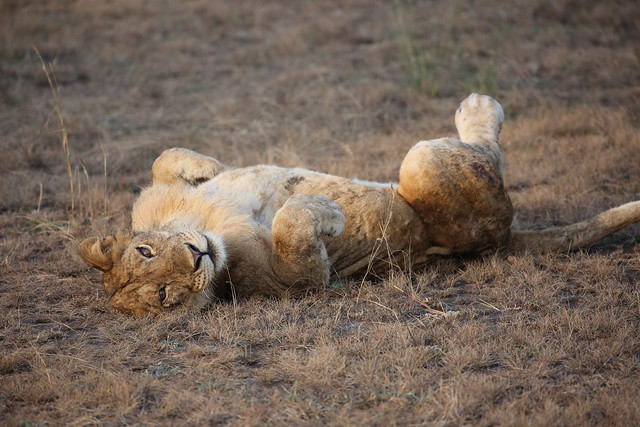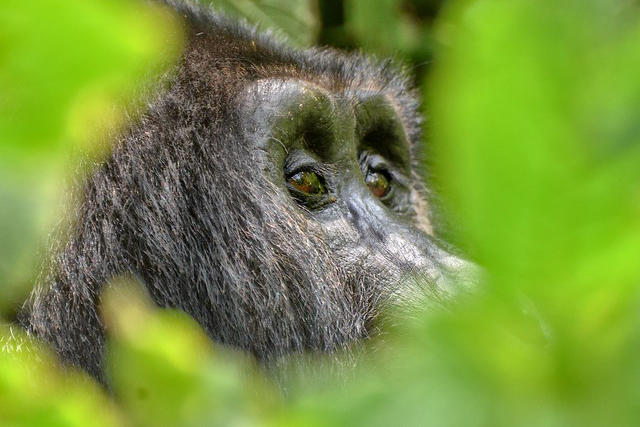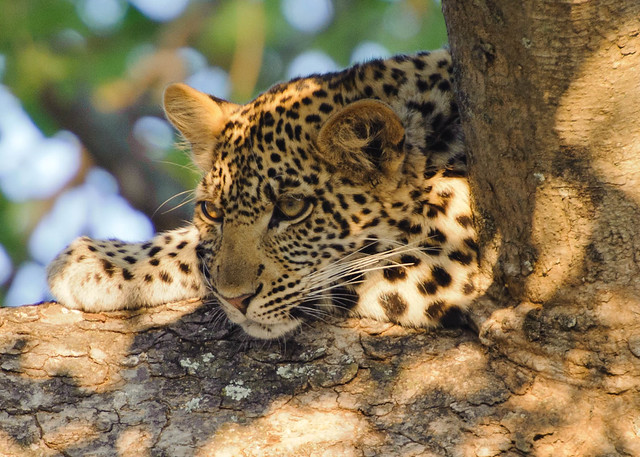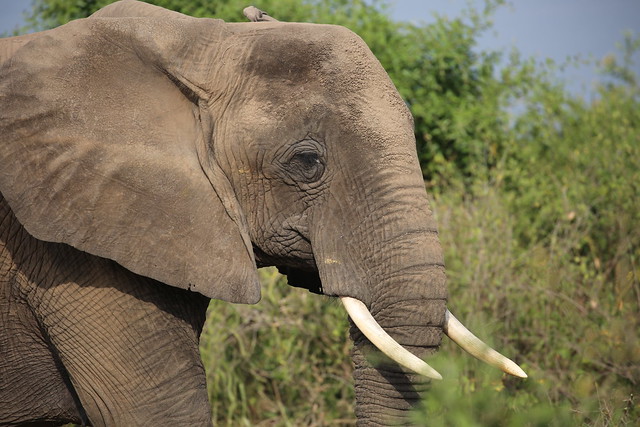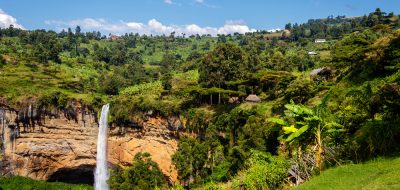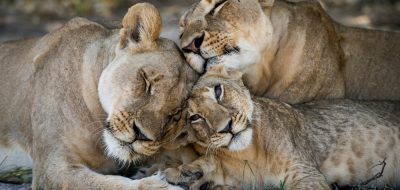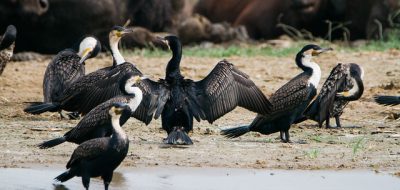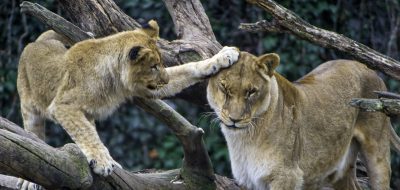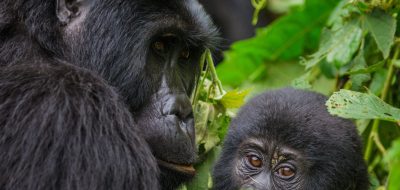Queen Elizabeth National Park which was founded in 1952 is the most popular in Uganda covering over 1978 kilometers squared. Located in Western Uganda, the National park is about 250 miles from the capital city of Uganda Kampala. Best known for the tree-climbing lions, leopards, and a large number of hippos, it has become a favorite for many tourists.
The National park has five habitats that make up the beautiful ecosystem and beautiful scenery that is found in Queen Elizabeth National Park. These have been divided into five that is swampy vegetation, forests, Acacia woodland, Lake Shore, and the savannah grasslands. When it comes to animals, there is no shortage of what you should expect when it comes to Queen Elizabeth National Park.
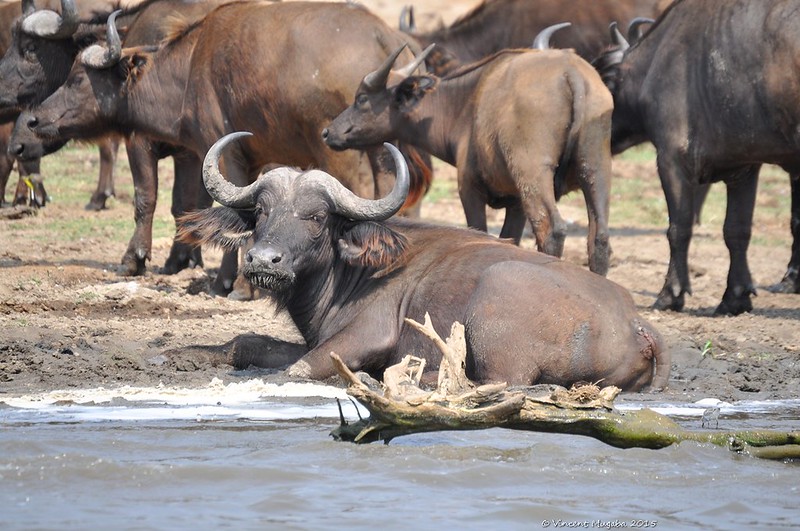
You get to see hippos, leopards, lions, elephants, kobs, buffalos, and crocodiles among others. Queen Elizabeth National Park is surrounded by many things that will keep you on your toes that is the Rift valley escarpment to the East, the Maramagambo forest filled with a variety of primates, the swamps and Lakes found in the area, and the Kazinga channel with both Lake Albert and Lake George, various hills and the Acacia trees all have attractions that you should check out while on safari to Queen Elizabeth National Park.
Safaris To Queen Elizabeth National Park
Park entry fees to Queen Elizabeth National Park
Non-foreign residents Adults $40
Children $20
EAC citizens Adults 20,000shs
Children 5000shs
Foreign residents Adults $30
Children $10
How to get to Queen Elizabeth National Park

You can use either road or air transport to get to Queen Elizabeth National Park. When using road transport, there are two routes that you can and one is from Kampala through Mbarara and then to the National Park. This is like 250 miles or more and it will take you to the Eastern side of the National Park. The second route will take you from Kampala through Fort Portal and then you head north towards the National Park. Tourists using air transport can get direct flights from Kajjansi airfield and the Entebbe International Airport. Domestic flights can easily be planned and scheduled and the airstrips around the Park where you can land include Ishasha, Kasese, and Mweya. Flights will take you about an hour or two from Kampala to the National park.
Sectors in Queen Elizabeth National Park
Queen Elizabeth National Park is divided into different sections and these make up the different ecosystem that is experienced within the National Park. The different sections that are found within Queen Elizabeth National Park include:
Ishasha sector & Tree Climbing Lions

Ishasha is found in the south-western part of the National Park 2 hours away from the Mweya peninsular. It is one of the most-visited parts of Queen Elizabeth best known for the climbing lions that are found in the area. Queen Elizabeth National Park has a total of about 50 climbing lions but the number can either increase or decrease due to different factors.
The lions can be seen lazily resting in the trees after hunting or when they are looking out for their prey. Some of the factors affecting the lions are the increasing number of people living around the National park, killing each other especially the dominant male, and natural causes. There was an incident that was recorded in 2018 where about 11 lions were found dead and the cause was poisoning and measures have been put in place to protect these climbing lions.
No one knows the real reason as to why the lions climb the trees although there are theories that say that it’s the best way for them to spot their prey all you need to know is that they always seem to be extremely comfortable while hanging in the tress. The giant cats can be seen all year round and some other animals that you might see depending on your luck include antelopes, buffalos, and elephants.
Kyambura Gorge
Kyambura Gorge covering the North-eastern part of Queen Elizabeth National Park is home to a wide range of animals and bird species. Also known as the valley of apes, Kyambura pronounced as ‘chambura’ acts as a buffer between humans and the National Park. There are so many reasons why you should visit the Kyambura gorge and these are the numerous activities that are carried out here some of these activities include:
Chimpanzee trekking
![]()
The Kyambura gorge is filled with thick vegetation, and swamps and covers over 10 square kilometers making it a perfect home for the chimpanzees. Chimpanzee tracking in Kyambura is either done in the morning or late afternoons and it will take you about 1 to 2 hours walk to get to the chimpanzees. Do not worry about the chimpanzees because they are used to human presence but you need to follow the rules and regulations given by the tour guides while chimp tracking. Chimpanzees in QENP are not all that aggressive because they have been habituated but some precautions need to be taken when chimpanzee tracking and these include:
• Do not use a flash when taking photos
• Always follow the tour guide
• Do not feed the animals
• Keep a distance between you and the primates
• Do not go chimp tracking if you are sick
• Do not approach the animals
Guided nature walks
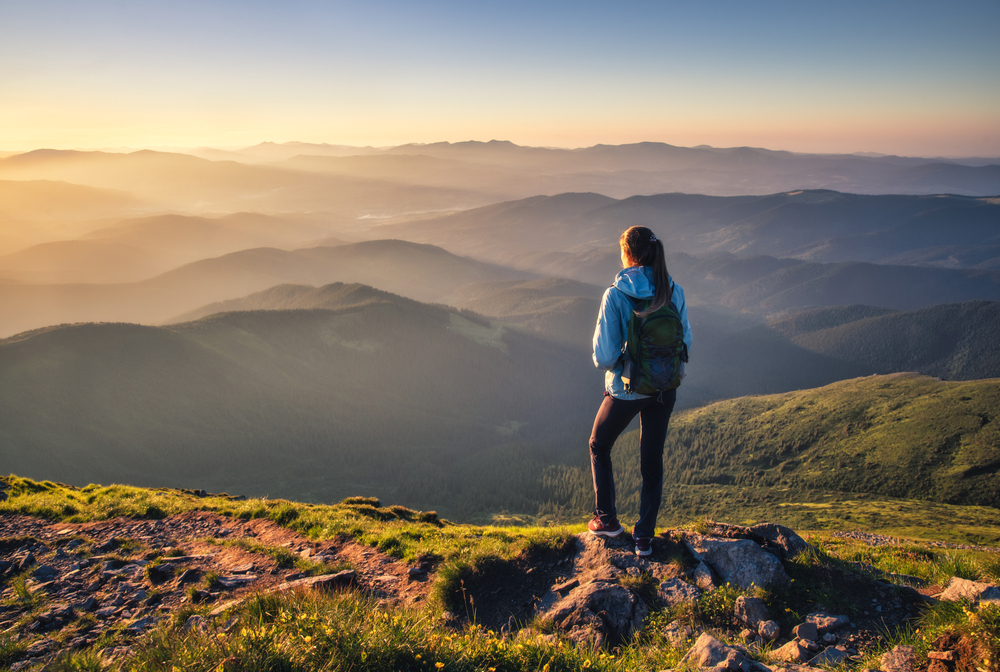
Guided nature walks are one of the best ways of exploring the Kyambura gorge. There are clearly marked routes that you will use and some of the exciting things that you get to see while on the walks include chimpanzees, vervet monkeys, white and black Columbus monkeys, baboons, and red-tailed monkeys. It is a bird haven and has numerous bird species that you can see while on your nature walks.
The Kazinga channel

Connecting two Lakes that is Lake George and Lake Edward, the Kazinga channel runs for 32 kilometers. Lake George is found on the Eastern part of the Kazinga channel and when it overflows, the excess water goes through the Kazinga channel and flows into Lake Edward which is on the Western side of the channel.
The Kazinga channel is divided into two parts that are North Kazinga and Kasenyi. Enjoy a boat cruise along the channel can easily be arranged to start at 11:00 am, 1:00 pm, 3:00 pm, and 5:00 pm for the different groups of tourists. Kazinga channel attracts lots of animals to its banks, especially during the dry season and some of the animals include lions, buffalos, elephants, kobs, hippos, and crocodiles among others. It is also home to different bird species that are best viewed during the wet season.
Mweya Peninsular
Mweya peninsular is located near the Kazinga channel in the Northern part. This is where most of the activities that are carried out in Queen Elizabeth National Park take place. It is just 20 kilometers away from the main Kasese road as you head to Mbarara. Mweya peninsular was previously a human settlement but it was later on in 1952 gazetted as a protected area.
There are over 400 settlements in the peninsular and these have so far lived around the area for a long time. Some of the activities that you can carry out while in Mweya peninsular include guided nature walks and mongoose tracking. Both activities can easily be carried out but with the help of a tour guide and for mongoose tracking, the activity takes about 3 hours and you learn how to track them and learn about their ways of life, get to see numerous bird species and a few animals.
Mweya peninsular is also known for the luxurious Mweya safari lodge which is found in the Northern part of the Peninsular. The lodge has the best view of Lake Edward and is one of the best lodges in the National Park. There are a few rules that you need to follow while in the Mweya peninsular and these are:
• Follow the instructions of the tour guide
• Do not make a lot of noise
• Do not eat while carrion out the different park activities
• Do not get close to the animals
The Katwe Crater Lake
Katwe Crater Lakes are found in the Mweya Peninsular and although at the moment they are extinct there is a distinct smell in form of sulphur that is around the crater Lakes. There are three craters and these are the Ndali-Kasenda crater, the Kyemengo crater which is the most beautiful, and the Bunyaraguru crater along the Kichwamba escarpment. Enjoy a drive around the Crater Lake and get clear views of the Kazinga channel, the hot springs, Lake Kitagata, Rwenzori Mountains, and the Great Rift Valley.
Maramagambo forest
Maramagambo forest is found in the central part of Queen Elizabeth National Park. The main attractions in the Maramagambo forest include the Kichwamba escarpment, primates like the black and white colobus monkeys, red-tailed monkeys, blue monkeys and baboons, Lake Edward, the bat caves, crater Lakes, bush babies, and chimpanzees.
The bat caves are something that you should check out but be aware of the pythons that live within the caves. The forest is good for guided nature walks, birding and hiking. It might take you about 2 hours to trek around the forest or more depending on the weather and the speed being used.
Kasenyi Plains
Kasenyi is located in the North-eastern part of Queen Elizabeth National Park and is open savannah grasslands where most of the animals can easily be spotted. Kasenyi is found near Lake George and compared to other grasslands found in the National Park, the Kasenyi plains have the largest number of animal species in the country and they are also home to several bird species.
Things to do in Queen Elizabeth National Park

There are several activities that are carried out in QENP and these include the following
Cultural tours
Enjoy a cultural tour around Lake Katwe where many locals can be seen locally mining salts. There are performances of songs and dances from the locals as a welcoming sign for tourists. You also get to experience the rich culture of the Banyaruguru and Toro people who live around the National Park.
Photo safaris
These are best taken from the crater side of the Equator. It has great views of the Queen’s pavilion which was set up in 1954. It was later renovated in 2007 and is one of the places that you should check out while in Queen Elizabeth National Park.
Game drives
Normally carried out in the dry season, game drives around the National Park will give you a chance to see various animals and some of these include antelopes, lions, hippos, leopards, elephants, kobs, and giraffes among others.
Birding
This is mainly done during the wet season and there are numerous birds that can be seen in their natural habitats. Look out for the migratory birds as well and some of the bird species you should look out for include the Shoebill and African fish eagle among others.
Nature walks
Nature walks around the National Park are only carried out when you are in the presence of a tour guide.
Boat cruises
Boat cruises are carried out along the Kazinga channel and these help in exploring the other side of the National Park with water animals like buffalos and hippos. T is a good chance to see other animals, especially during the dry season since they converge around the channel for water.
Chimp tracking
Chimp tracking is mainly done in the Maramagambo forest. Best carried out during the dry season, other primates you get to see while tracking chimps include red-tailed monkeys, baboons, vervet monkeys, and, black colobus monkeys.
Balloon rides
Balloon rides are offered at an extra cost and are done very early in the morning. They normally follow the weather and therefore if the weather is bad, they get cancelled. The rides offer tourists a great aerial view of the animals and flora found in the National Park.
Wildlife in Queen Elizabeth National Park

The National Park has a wide range of wildlife that lives in the different habitats within the National Park. Wildlife viewing can be done in the different parts of the National Park and each section has something that you should look out for. If you are looking for leopards and the Giant Forest hog, the best place is the channel track which is found on the Kazinga channel and is also known as the leopard loop.
A boat ride along the Kazinga channel will give you a clear view of the hippos and other water animals. The Mweya peninsular is the most visited part of the Queen Elizabeth National Park because it has large herds of wildlife. The best time for wildlife viewing is during the dry season which is from January to February and June to August.
Animals in Queen Elizabeth National Park
Queen Elizabeth National Park has over 95 different animal species which makes it the National Park with the largest number of animals in Uganda. It is famously known for a large number of hippos which amounts to over 5000. Some of the animals that are found in the Queen Elizabeth National Park include lions, Hyenas, Hippos, Leopards, Elephants, Forest hogs, Kob (commonly known as the Ugandan Kob), Forest hogs, baboons, monkeys like the vervet monkeys, black and white colobus monkeys and the red-tailed monkeys, Bush babies, and many more others.
Queen Elizabeth National Park is home to thousands of animals that live in different habitats in the different parts of the National Park. The Park is best known for having some of the best games around the world and every tourist gets to see different types of animals including the big five.
• The Buffalos, queen Elizabeth National Park has over 10000 buffalos that can be seen walking around the Park in herds. This so far is the highest number of buffalos recorded in the East African region and the reason why they travel in groups is to protect each other from hunters and carnivores like lions and leopards.
• Elephants, the African elephants that are found in Queen Elizabeth National Park are unique in their own way and most people say that if you look closely at their ears, there is a formation of the African continent. There are about 2500 recorded elephants in Queen Elizabeth national park that can be seen along the Kazinga channel and other parts of the Park.
• Hippos, the National Park has about 5000 hippos that can be seen while taking a boat cruise along the Kazinga channel. You can as well view them from a game drive but the bruise cruise will give you a more detailed view of the hippos.
Birds in Queen Elizabeth National Park
Queen Elizabeth National Park is in the 6th position in the whole world when it comes to having a large number of bird species and it is in the 2nd position in Africa after the Virunga National park. There are about 612 recorded bird species in the Park with the migratory birds coming in the months of November to April. Some of the bird species are migratory whereas others are endemic to the National park and these can be best seen during the wet season. There are different habitats from where you can view the birds and these include the following:
• Katuguru Bridge area, is filled with papyrus and is found along the Kazinga channel. Some of the bird species found here include the pied Kingfisher, Lesser swamp swabler, white-winged greater winged warbler, papyrus gonolek, and the Malachite kingfisher.
• Ishasha sector, although best known for the climbing lions, it is also a birding spot, and bird species here include the African crowned eagle, grey kestrel, African shoebill, Cisticola, African green pigeon, and the African wattled plover.
• Maramagambo forest, bird species here include the African emerald cuckoo, African finfoot, red-throated wryneck, African mustached warbler, blue-shouldered Robin Robin-chat, the and brown Illadopsis among others.
• Kasenyi Area, bird species found in the Kasenyi area include the palm but culture, black-bellied bustard, croaking Cisticola, white-tailed lark, hooded vulture, long-crested and brown brown-backed Robin among others.
• Mweya peninsular, found next to the Kazinga channel, bird species found here include the grey-headed Kingfisher, Nubian woodpecker, swamp nightjar, swift’s swallows, and little bee-eater.
• Lake Kikorongo has bird species which include the African Jacana, scared Ibis, shoebill, knob-billed duck, and saddle-billed stork among others.
When to visit Queen Elizabeth National park
The best time to visit the Queen Elizabeth National park depends on the seasons and these keep on changing. Due to its closeness to the Equator, the National Park has two seasons that is the wet season and the dry season. The dry season is experienced in two phases that is from January to February and then from June to September.
The dry season is considered to be the best time because of the large numbers of animals that can be seen converging along the waterholes. The wet season is also a good time to visit the National Park, especially for tourists who love birding. The wet season is experienced from August to November and from February to May.
The dry season is also known as the peak season and this is because of the many tourist that can be seen during this period. All costs during the peak season are doubled and tourists are advised to book early. The wet season also known as the wet season receives few tourists and the best time for anyone who doesn’t like crowds and on a budget.
All activities can be carried out throughout the year but the best time for Game drives, nature walks, hiking and primate tracking are best done during the dry season. You will however be able to also see the numerous animals during the wet season and carry out other activities.
Where to stay in Queen Elizabeth National Park
There are several places where you can stay while on a safari to Queen Elizabeth National Park and these are categorized into three that is budget, mid-range, and luxurious accommodation facilities. The best accommodation depends on your budget but just know that there are facilities that can fit in every budget both within and around Queen Elizabeth National Park.
Budget accommodation facilities: some of the budget facilities around the Park include Samba safari camp, Pumba safari camp in Kyambura, Mweya hostel and the Kazinga channel resort among others.
Mid-range accommodation facilities: these include the buffalo lodge, Engiri safari lodge, Enganzi game lodge, Ihamba lodge and Kingfisher lodge in Kichwamba among others.
Luxury accommodation facilities include Kyambura game lodge, Jacana safari lodge, Mweya safari lodge, Ishasha wilderness lodge, Kyambura gorge lodge and the Hippo safari lodge among others.
What to bring and wear while on a safari to Queen Elizabeth National Park
• Put on neutral colors
• Put on long-sleeved shirts and trousers
• Bring anti-malarial drugs with you because of the many mosquitoes in the Park
• Wide brimmed hats
• Sunscreen
• Hiking boots
Queen Elizabeth National Park safety tips
Queen Elizabeth national Park is an open grassland where animals are not confined to one place and therefore they move from one place to the next. They basically own the National Park and you are supposed to give them a lee way when you find them. There are many safety precautions that you can follow while in QENP and below is a list of some of the rules that will ensure both your safety and the safety of the wildlife.
• Do not walk in the park alone
• Do not approach the animals even when they are close to you
• Carry a first aid kit with you in case of any accidents
• Do not alight your vehicle during the game drives
• Make sure that you do not make a lot of noise for example do not honk, turn off your phone and radios
• For those that love camping, keep your food away from the animals and turn out the fire after cooking
• Remember that the animals have a right of way so do not over speed
• Avoid hippos at all costs especially if they are in water.
Explore the queen Elizabeth National park while on a safari to Uganda and get the best time of your life with all that the Park has to offer.



